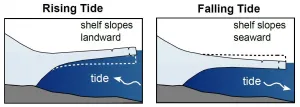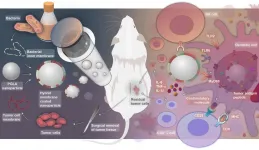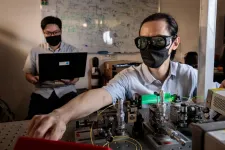(Press-News.org) WASHINGTON--Tidal stresses may be causing constant icequakes on Saturn's sixth largest moon Enceladus, a world of interest in the search for life beyond Earth, according to a new study. A better understanding of seismic activity could reveal what's under the moon's icy crust and provide clues to the habitability of its ocean.
Enceladus is about 500 kilometers in diameter and almost entirely covered in ice. The moon is nearly 10 times as far away from the Sun as Earth and its bright surface reflects most sunlight, making it very cold, yet researchers have long speculated that the ice encases an underlying liquid ocean.
The moon likely experiences massive tidal forces caused by Saturn and the planet's other, larger moons--similar to the way Earth's Moon causes tides on Earth. These tidal motions inside Enceladus warm its interior, crack the surface and sometimes squeeze tall geysers of water vapor through notable cracks called the tiger stripe fractures.
The new study used observations of Antarctic ice shelves to suggest tides on Enceladus may also cause small quakes in the ice at the moon's fractures, like icequakes observed on Antarctica's floating ice sheets.
"[Moons like] these are places that are exciting because they might have life," said Kira Olsen, a geophysicist at NASA's Goddard Space Flight Center. She said that since life is thought to have first developed in our oceans, liquid oceans under the ice of other worlds could be a good place to search for life. The icy crust of Enceladus might also protect the water below from radiation, making it more habitable.
The new study was published in the Journal of Geophysical Research: Planets, AGU's journal for research on the formation and evolution of the planets, moons and objects of our solar system and beyond.
"We have ideas of how thick the ice could be, but we don't have direct observation. Studying ice quakes is a way to get at that information," Olsen said.
Internal tides
To learn more about how Enceladus' tiger fractures might be moving, Olsen and her colleagues turned to floating ice shelves in Antarctica as the closest analogue on Earth for the types of activity they were seeing on Enceladus. They could then use their knowledge about how certain surface features on our planet produce seismic activity to estimate what kind of seismic activity is happening on the distant moon.
The researchers analyzed data collected by seismometers along the Ross Ice Shelf in the southern continent between 2014 and 2016 and compared these to satellite images of the area. They paid particular attention to two seismometers placed next to large rifts on the ice slab.
They related the seismic activity to the stress occurring along these rifts. The majority of icequakes on the Ross Ice Shelf occurred when the rifts were pulling apart, which happens when tides are falling.
We have no measurements of seismic activity on Enceladus, but Olsen and her colleagues created models that compared the types of fractures they saw on the moon's surface with those on the Ross Ice Shelf.
These models showed that the largest amount of seismic activity on Enceladus likely corresponded to the tides. Peak seismic activity there occurs when Enceladus is 100 degrees past the nearest approach to Saturn during its orbit. The ocean underneath the ice at this point acts something like water inside a sloshing balloon. The ice fractures are created at the points of highest stress, where the balloon would break apart.
The icequakes aren't massive along these cracks, even at the peak periods of stress. Olsen describes them more like "almost continuous little pops and fractures.
Mark Panning, a research scientist at NASA's Jet Propulsion Laboratory who was not involved in the new study, said that while the Cassini spacecraft revealed the moon is geologically active, it's difficult to tell how that translates to seismic activity. "The study represents a really key way of investigating what seismicity on Enceladus and other tidally activated icy worlds may look like by looking at the best analogs we can find on Earth," he said.
Olsen said scientists should aim to place seismometers within 10 kilometers of these fractures in any future missions to Enceladus to learn more about what's going on below.
"It's not a quiet out of the way place, but it's a pretty good place to study," she said.
More information about the seismic activity could then teach us more about the thickness of the ice crust on Enceladus. For now, no missions to Enceladus have been planned, but the European Space Agency is planning the JUICE mission to one of Jupiter's icy moons, Europa.
Olsen said that similar work could then be conducted on Titan, Saturn's largest moon, a world also covered with ice that may conceal liquid oceans and is another top pick for potential extraterrestrial life. NASA's Dragonfly mission is scheduled to visit Titan in 2036.
"This kind of work is one of the best ways to try to get an idea of what behaviors we may see on a planetary body that would be an incredible place to do more science," Panning said.
INFORMATION:
AGU (http://www.agu.org) supports 130,000 enthusiasts to experts worldwide in Earth and space sciences. Through broad and inclusive partnerships, we advance discovery and solution science that accelerate knowledge and create solutions that are ethical, unbiased and respectful of communities and their values. Our programs include serving as a scholarly publisher, convening virtual and in-person events and providing career support. We live our values in everything we do, such as our net zero energy renovated building in Washington, D.C. and our Ethics and Equity Center, which fosters a diverse and inclusive geoscience community to ensure responsible conduct.
Notes for Journalists:
This research study will be freely available for 30 days. Download a PDF copy of the paper here. Neither the paper nor this press release is under embargo.
Paper title:
"Projected seismic activity at the tiger stripe fractures on Enceladus, Saturn, from an analog study of tidally modulated icequakes within the Ross Ice Shelf, Antarctica"
Authors:
Kira G. Olsen, NASA Goddard Space Flight Center, Greenbelt, MD, USA
Terry A. Hurford, NASA Goddard Space Flight Center, Greenbelt, MD, USA
Nicholas C. Schmerr, University of Maryland, College Park, MD, USA
Mong-Han Huang, University of Maryland, College Park, MD, USA
Kelly M. Brunt, NASA Goddard Space Flight Center, Greenbelt, MD, USA
Sophia Zipparo, University of Maryland, College Park, MD, USA
Hank M. Cole, Colorado State University, Fort Collins, CO, USA
Richard C. Aster, Colorado State University, Fort Collins, CO, USA
Newborn infants and babies aged up to three months should be stimulated to manipulate objects and observe adults performing everyday tasks. This incentive helps their social, motor and cognitive development, researchers note in an article published in the May 2021 issue of the journal Infant Behavior & Development.
According to the authors, from the earliest age babies watch adults carrying out activities such as handling utensils and putting them away in drawers or closets. They should themselves have frequent contact with objects to develop the ability to hold things and reach out for them. Through social interaction, ...
Diabetes is the leading cause of kidney failure in the United States, but identifying type 1 or type 2 diabetes patients at high risk for progressive kidney disease has never had a sure science behind it.
Historically, assessing kidney function meant looking at estimated glomerular filtration rate, a calculation that determines how well blood is filtered by the kidneys, and urine albumin excretion, a urine test to detect the amount of the protein albumin, which is filtered by the kidneys. However, both tests have limited predictive power in early stage diabetes when kidney function is normal.
The therapeutic approach to both type 1 and type 2 diabetic ...
A multi-institutional study has discovered spontaneous mutations in RNF2 (RING2) gene as the underlying cause of a novel neurological disorder. This Undiagnosed Diseases Network (UDN) study was led by Dr. Shinya Yamamoto, investigator at the Jan and Dan Duncan Neurological Research Institute (NRI) at Texas Children's Hospital and assistant professor at Baylor College of Medicine, and Dr. Vandana Shashi at Duke University Medical Center. Using a combination of comprehensive clinical tests, trio genome sequencing and functional studies in the fruit flies, and global gene matchmaking efforts, the teams found ...
Amsterdam, July 8, 2021 - While the literature on the digital divide has widely addressed the digital gender gap, its potential implications for electronic government (e-government) / digital government research and practice have hardly been studied. In this Special Issue of Information Polity experts characterize the current state of understanding of the issues surrounding digital government and gender and present an agenda for future research.
Gender is a neglected topic in the literature on digital government. According to the International Telecommunications Union, women are lagging behind men in making ...
demic have already had a dramatic impact on the prevailing oral health care model and will continue to do so. The paper "Advocacy for a Digital Oral Health That Leaves No One Behind," published in the JDR Clinical & Translational Research (JDR CTR), promotes the use of digital tools to offer opportunities to improve healthy behavior, lower risk factors common to oral diseases and other noncommunicable diseases and contribute to reducing oral health inequalities.
To mitigate the impact of the COVID-19 pandemic lockdowns, systems were quickly put in place in most countries to respond to dental emergencies, ...
Consuming a protein supplement, specifically protein hydrolysate, during carbohydrate-restricted training was helpful for improving training intensity in women, but not in men.
That's according to new research which will be part of a presentation this week at The Physiological Society's Annual Conference Physiology 2021.
Most nutrition guidelines for athletes are based on research in men only. This study, by Tanja Oosthuyse and her colleagues, emphasizes that this shouldn't be the case, because nutritional research findings in men don't always apply to women.
While the protein supplement helped training intensity in women, it did not improve training intensity and instead resulted in modest negative effect in men. It made exercise ...
July 8, 2021 - Women with recurrent urinary tract infections (UTIs) experience frustration related to their treatment - particularly the risks from repeated use of antibiotics, according to a focus group study in The Journal of Urology®, Official Journal of the American Urological Association (AUA). The journal is published in the Lippincott portfolio by Wolters Kluwer.
"This study was prompted by our experience treating countless women with recurrent UTIs referred to our specialized Female Pelvic Medicine and Reconstructive Surgery center," comments senior author Ja-Hong Kim, MD, of UCLA Center of Women's Pelvic Health. "The vast majority were understandably dissatisfied with their care pathway, which was primarily antibiotic-focused ...
Ibaraki, Japan - Most kids dream of growing up to be astronauts; but the downside of spending extended amounts of time in low gravity is that astronauts' muscles tend to shrink and weaken through disuse. Now, researchers from Japan have identified a protein that affects how muscles respond to space flight.
In a study published in June 2021 in Communications Biology, researchers from the University of Tsukuba have revealed that nuclear factor E2-related factor 2, or NRF2, helps keep muscles from becoming weak in low gravity.
Muscle atrophy, or weakening, is a common feature of disease and aging. It can also occur after a long period of inactivity, such as during space flight, when astronauts don't need to use their muscles as much as they do on Earth to support ...
Thanks to the rapid development of nanotechnology, a research team led by Profs. NIE Guangjun, WU Yan and ZHAO Yuliang from the National Center for Nanoscience and Technology (NCNST) of the Chinese Academy of Sciences (CAS) recently designed personalized tumor vaccines based on bacterial cytoplasmic membranes and cell membranes from resected tumor tissue. This work was published in Science Translational Medicine.
Cancer vaccines are an effective anti-tumor therapeutic option that utilize tumor antigens to stimulate patients' immune response and specifically kill tumor cells. Postoperative recurrence and metastasis after surgery can thus be effectively inhibited by the activated immune system. Therefore, ...
Quantum key distribution (QKD) is a method for secure communication that uses quantum mechanics to encrypt information. While the security of QKD is unbreakable in principle, if it is incorrectly implemented, vital information could still be stolen by attackers. These are known as side-channel attacks, where the attackers exploit weaknesses in the setup of the information system to eavesdrop on the exchange of secret keys.
Researchers from the National University of Singapore (NUS) have developed two methods, one theoretical and one experimental, to ensure that QKD communications cannot be attacked in this way. The first is an ultra-secure cryptography protocol that can be deployed in any communication network that needs long-term ...




